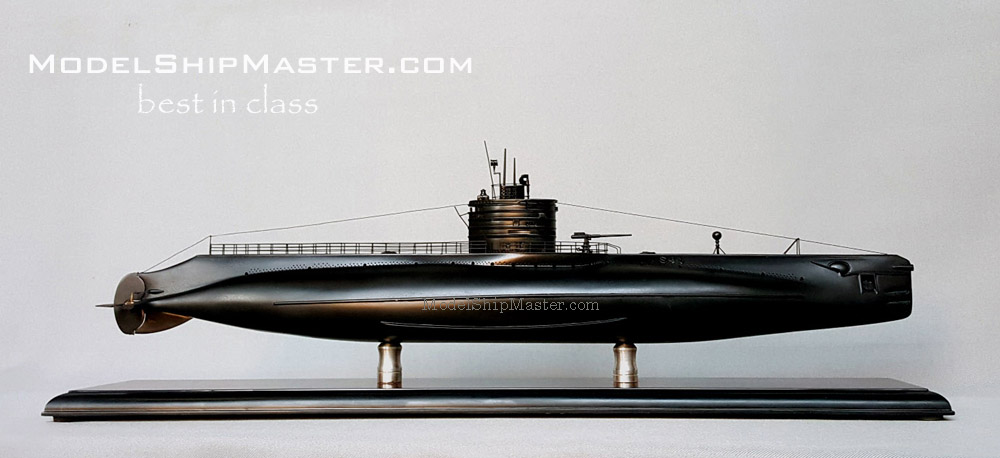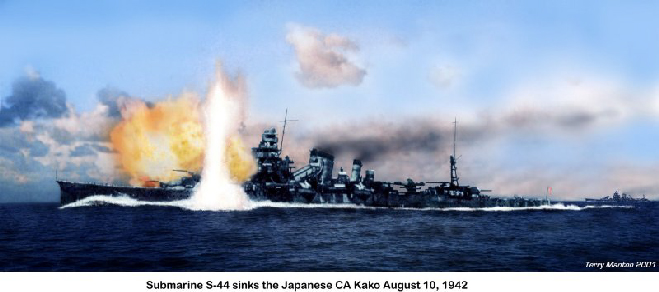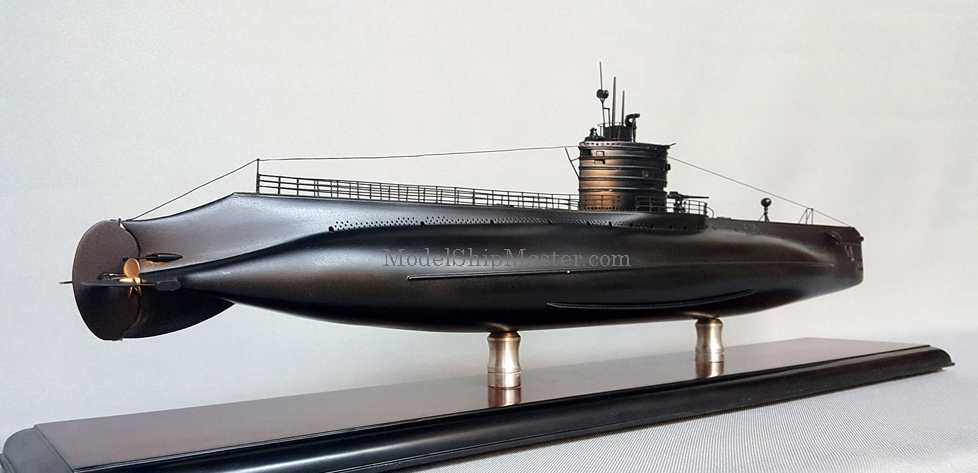|


256-bit encryption
$500,000 protection

|
S-44 SUBMARINE
The first US
submarine to sink an enemy heavy cruiser
"The
model arrived safely and looks great! Once I have
it in the display case with the folded flag and
history print-outs, I'll send you a picture. Thanks
again for the beautiful work. Mike T. Rickover Commandant. Rickover
Naval Academy"

USS S-44 was a
S-class submarine of the United States
Navy. Her keel was laid down on 19 February 1921.
She was launched on 27 October 1923, and
commissioned on 16 February 1925.
World War II:
In the spring of 1941,
as American involvement in World War II increased,
the Panama S boats were ordered back to the east
coast for overhaul. With sister
ships S-42 and S-46, S-44 proceeded to New London,
Connecticut, and in November went to Philadelphia,
where the work was completed. Trials took S-44 into
the new year, and on 7 January 1942, she got
underway for Panama. Arriving on 16 January, she
departed Balboa on 24 January with S-21, S-26,
and S-28, to conduct a security patrol in the
western approaches to the canal. Within a few hours,
however, she was engaged in rescue operations
for S-26, which had been rammed and sunk by
submarine chaser PC-460.
First
patrol, March 1942:
From
Panama, the division (now SubDiv 53) was ordered to the
southwest Pacific. Starting across the Pacific in early
March, the boats reached Brisbane in mid-April, and
within ten days, S-44 was on her first war patrol. She
cleared Moreton Bay on 24 April. On 29 April, she began
running submerged during the day and surfacing at night
to recharge batteries and intake fresh air. By 2 May,
she was in her patrol area, New Britain-New
Ireland waters. Six days later, she sighted a ship
through a haze of rain and launched two torpedoes which
missed. She attempted to close the range. However the
surface ship easily outdistanced her. The next
afternoon, she attempted to close on a Japanese
destroyer, east of Adler Bay, but again was easily
outrun. On 10 May, off Cape St. George, she closed on
another target but was sighted and attacked.
In late afternoon of 12 May, 15 miles from the cape, she
encountered a merchantman and a trawler escort. She
launched four torpedoes while surfaced and hit with two.
The Shoei Maru, a vessel of over 5000 tons was sunk. A
Japanese escort attacked S-44 and dropped sixteen or
depth charges, none of which was close.
.jpg)
2nd
patrol, June 1942:
On 7 June she left of Moreton Bay on a course for
the Solomon Islands. Within the week, she was on patrol
off Guadalcanal, operating from there to Savo and Florida
Island. A few days later, she shifted south of
Guadalcanal and on 21 June sank the converted gunboat Keijo
Maru. At 14:15, S-44 fired her torpedoes. Just 3 minutes
later the enemy aircraft dropped a bomb which exploded
close to the submarine, bending the holding latch to the
conning tower and allowing in 30 gallons of sea water.
This damaged the depth gauges, the gyrocompass, and the
ice machine, besides causing leaks.
3rd patrol, July 1942:
On 31 July, S-44 commenced patrolling the Rabaul-Tulagi shipping
lanes. The next day, she sighted a convoy off Cape
St. George, but heavy swells hindered depth control and
speed, and prevented her from attacking. From Cape St.
George, S-44 moved up the east coast of New
Ireland to North Cape and Kavieng, where she waited.
On 7
August, the American offensive opened with landing of
the 1st Marine Division on the beaches of the Solomon
Islands of Guadalcanal and Tulagi. On 9 August, off Savo
Island, Cruiser Division 6 of the Imperial Japanese
Navy had inflicted one of the worst defeats of the
war on American and Australian surface ships.
The next morning, the victorious enemy cruisers neared
Kavieng, bound for home. At 07:50, S-44 sighted the
formation of four heavy cruisers at less than 900 yards.
At 08:06, she fired four Mark 10 torpedoes at the rear
ship, only 700 yards away. By 08:08, three torpedoes had
exploded and the heavy cruiser Kako was sinking.
S-44 had claimed the largest Japanese man-of-war in the
Pacific War to date.

With one ship sunk on each patrol so far, she set a
record no other S-boat would match.
4th patrol, September 1942:
On 22 September, she began surfacing only at night, and,
two days later, took patrol station off New Georgia to
interdict Japan's Faisi-Guadalcanal supply line. On the
morning of 4 October, she attacked a destroyer, then
survived an intensive depth charge attack with seemingly
minor damage. When she submerged the next day,
however, the submarine began taking water. She surfaced,
made repairs, then submerged to 50 feet.
Leaks
were found in her motor room and torpedo room flappers.
The latter were jacked shut, but the former continued
spraying water onto both motors. Within an hour, four
Japanese destroyers had moved into the area. S-44 went
to 70 feet. The leak worsened. The motors
were covered in canvas and sheet rubber and the crew
waited for the destroyers to pass over her position. As
they disappeared, S-44 moved up to 55 feet and repairs
were made on the flapper. That night, further
repairs were made while the ship was surfaced off Santa
Isabel Island; and, by midnight, the S-boat was en route
back to her patrol area.
5th patrol, September 1943:
On 26 September, S-44 departed Attu on her last war
patrol. One day out, while en route to her
operating area in the northern Kuril Islands, she was
spotted and attacked by a Japanese patrol plane.
Suffering no damage, she continued west. On the night of
7 October, she made radar contact with what she thought
was a "small merchantman" and closed in for a surface
attack. Several hundred yards from the target, her deck
gun fired and was answered by a salvo. The "small
merchantman" in fact was the Shimushu-class escort Ishigaki.
An emergency dive was ordered, but too late. She
then took several hits in the control room, the forward
battery room, and elsewhere.
S-44 was ordered abandoned. A pillow case was raised
from the forward battery room hatch as a flag of
surrender. Eight men were believed to have got off
the sinking submarine, but only two were picked up by
the escort. Following interrogation, the two
survivors were sent to the Ashio copper mines. It
was only after the two men were liberated that the Navy
was able to determine what had happened by S-44, which
had previously been listed as “Missing—presumed lost.”

This 27" long (1/100 scale)
primarily wood S-44
submarine model is permanently displayed at the
Rickover Naval Academy.
$2,300
Shipping and insurance in
the contiguous USA included.
Other places: $300 flat rate.
Model is built per commission only. We require only a
small deposit to start the process$500  The
remaining balance won't be due until the model is
completed, in 3-4 months. The
remaining balance won't be due until the model is
completed, in 3-4 months.
ModelShipMaster builds any
models, at virtually any sizes. Contact us at
Services@ModelShipMaser.com
to inquire.
|